Abstract
Reactive oxygen species (ROS) have been implicated in the pathogenesis of numerous disease processes. Epithelial cells lining the respiratory airways are uniquely vulnerable regarding potential for oxidative damage due to their potential for exposure to both endogenous (e.g., mitochondrial respiration, phagocytic respiratory burst, cellular oxidases) and exogenous (e.g., air pollutants, xenobiotics, catalase negative organisms) oxidants. Airway epithelial cells use several nonenzymatic and enzymatic antioxidant mechanisms to protect against oxidative insult. Nonenzymatic defenses include certain vitamins and low molecular weight compounds such as thiols. The enzymes superoxide dismutase, catalase, and glutatione peroxidase are major sources of antioxidant protection. Other materials associated with airway epithelium such as mucus, epithelial lining fluid, and even the basement membrane/extracellular matrix may have protective actions as well. When the normal balance between oxidants and antioxidants is upset, oxidant stress ensues and subsequent epithelial cell alterations or damage may be a critical component in the pathogenesis of several respiratory diseases. Oxidant stress may profoundly alter lung physiology including pulmonary function (e.g., forced expiratory volumes, flow rates, and maximal inspiratory capacity), mucociliary activity, and airway reactivity. ROS may induce airway inflammation; the inflammatory process may serve as an additional source of ROS in airways and provoke the pathophysiologic responses described. On a more fundamental level, cellular mechanisms in the pathogenesis of ROS may involve activation of intracellular signaling enzymes including phospholipases and protein kinases stimulating the release of inflammatory lipids and cytokines. Respiratory epithelium may be intimately involved in defense against, and pathophysiologic changes invoked by, ROS.
Full text
PDF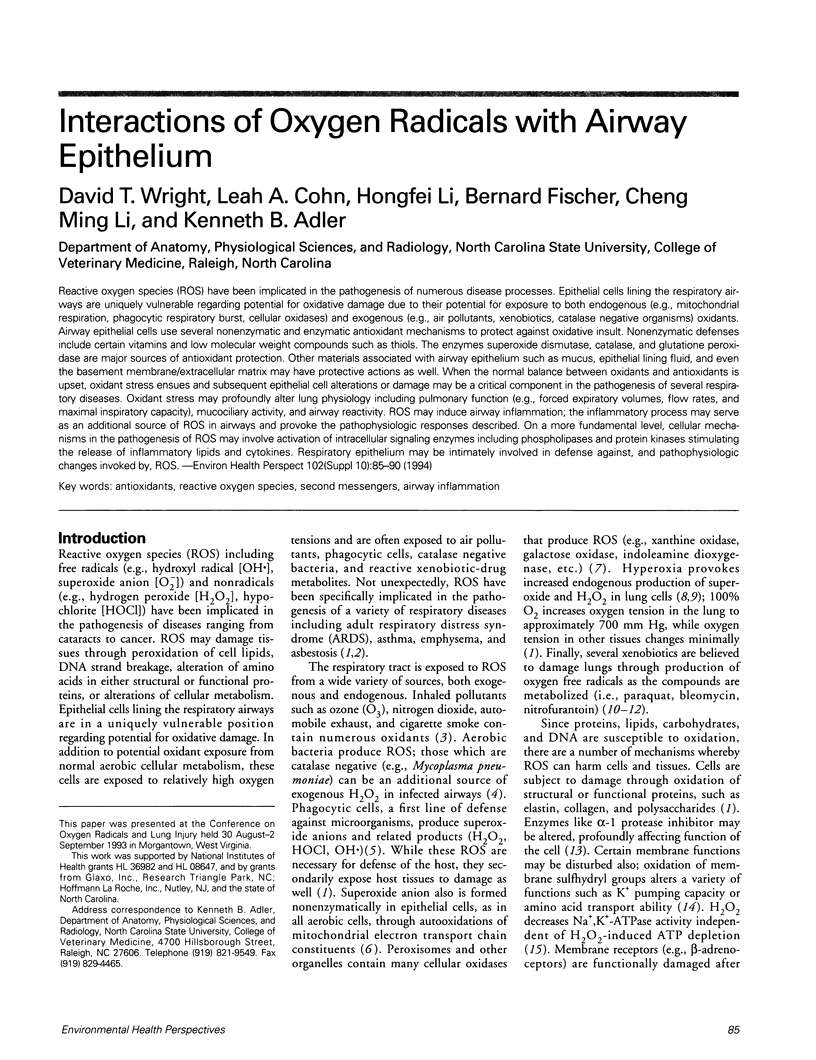
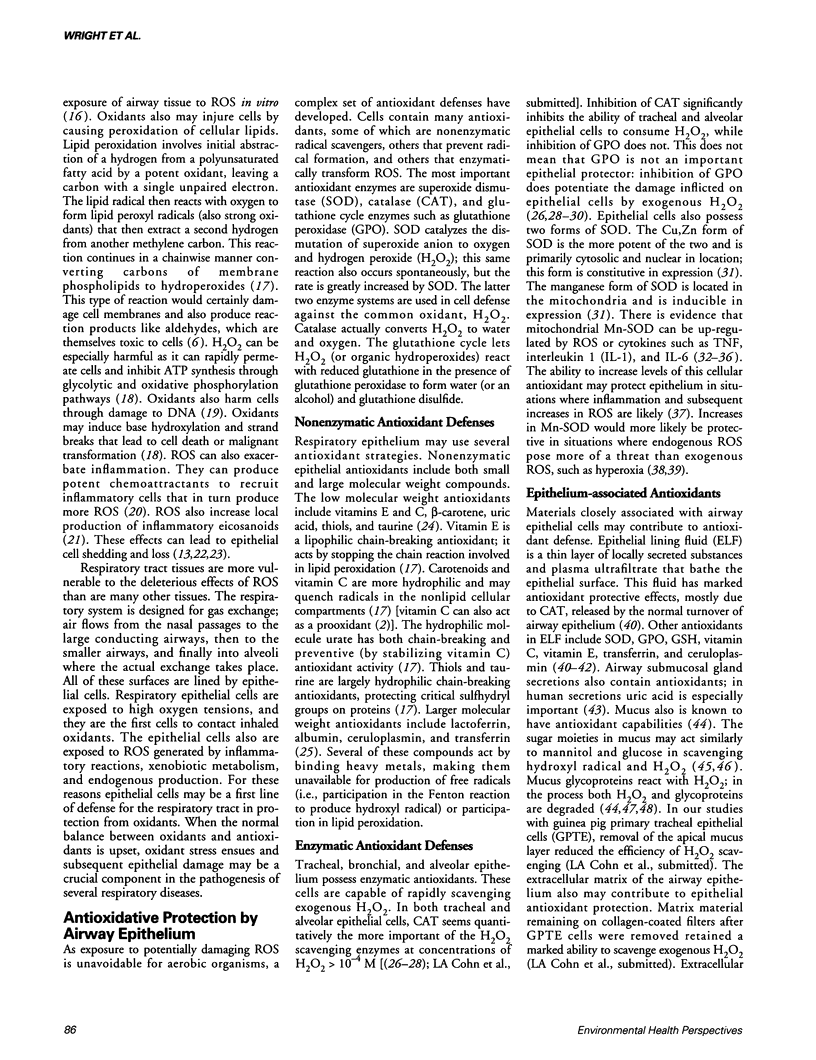
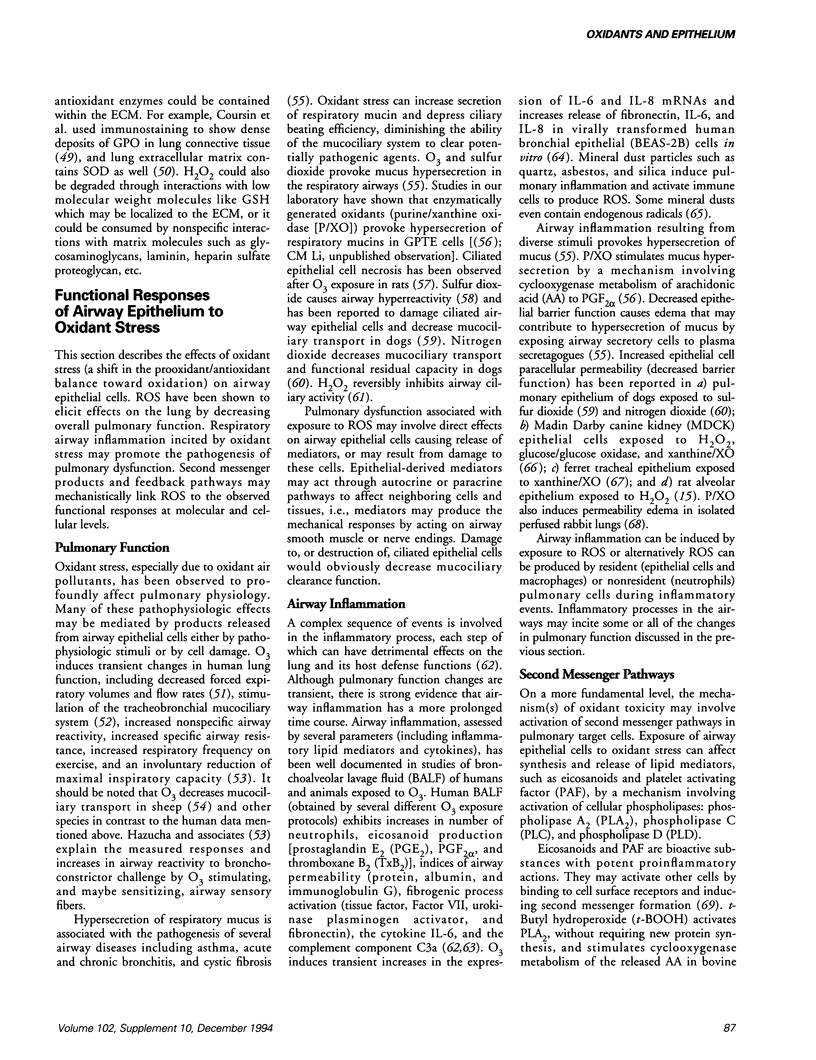
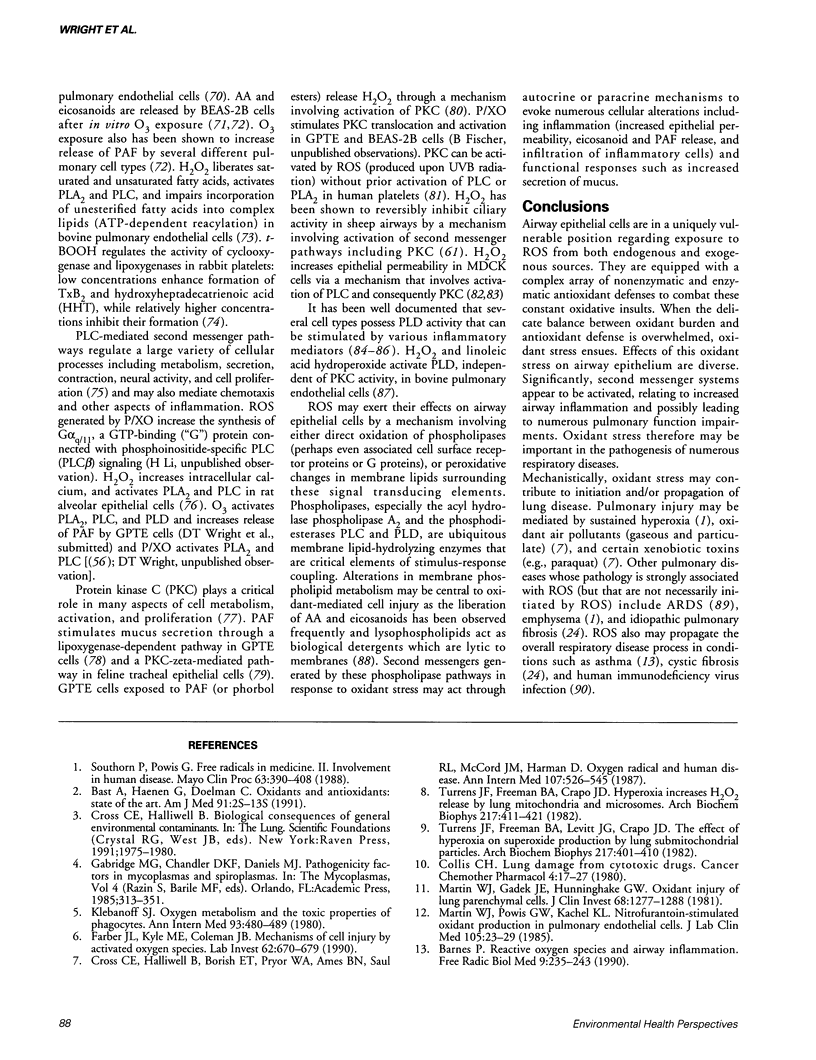
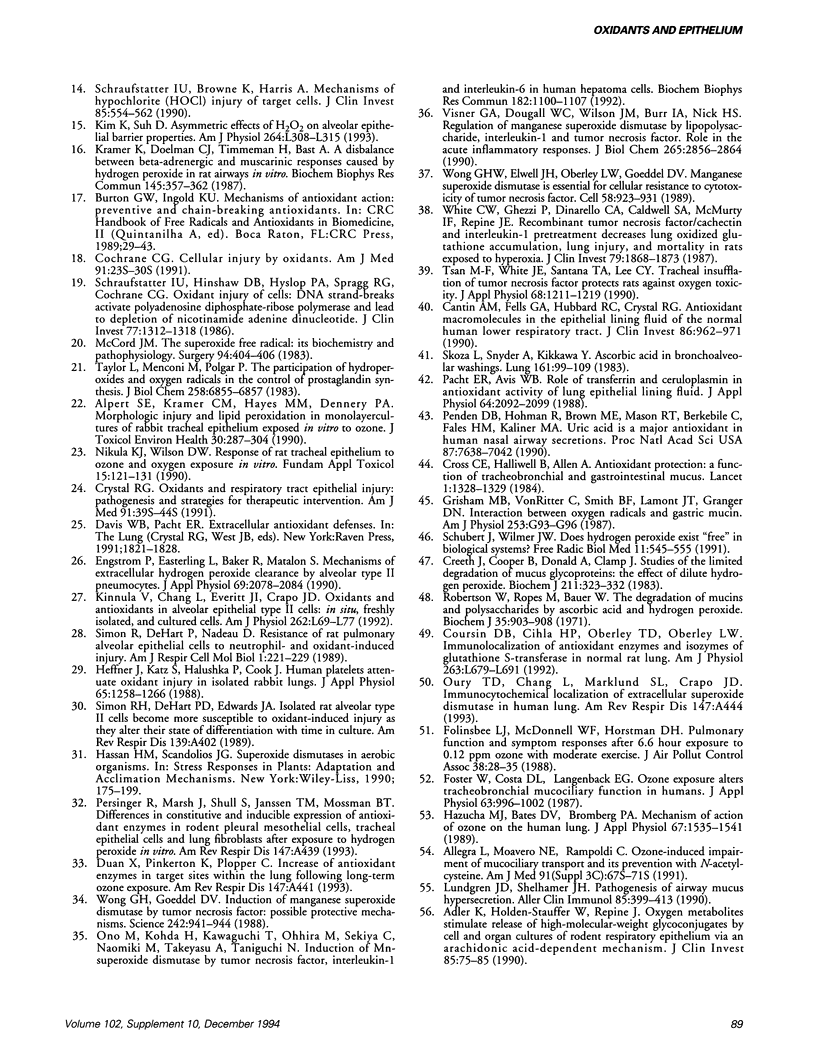
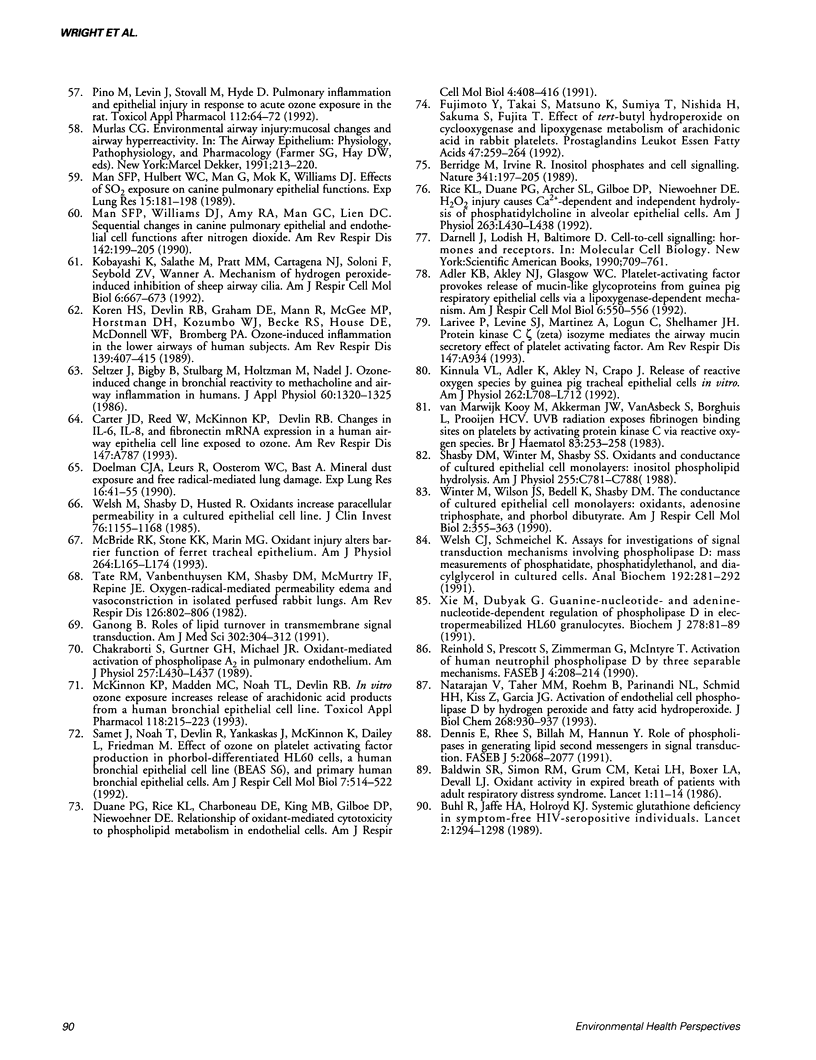
Selected References
These references are in PubMed. This may not be the complete list of references from this article.
- Adler K. B., Akley N. J., Glasgow W. C. Platelet-activating factor provokes release of mucin-like glycoproteins from guinea pig respiratory epithelial cells via a lipoxygenase-dependent mechanism. Am J Respir Cell Mol Biol. 1992 May;6(5):550–556. doi: 10.1165/ajrcmb/6.5.550. [DOI] [PubMed] [Google Scholar]
- Adler K. B., Holden-Stauffer W. J., Repine J. E. Oxygen metabolites stimulate release of high-molecular-weight glycoconjugates by cell and organ cultures of rodent respiratory epithelium via an arachidonic acid-dependent mechanism. J Clin Invest. 1990 Jan;85(1):75–85. doi: 10.1172/JCI114436. [DOI] [PMC free article] [PubMed] [Google Scholar]
- Alpert S. E., Kramer C. M., Hayes M. M., Dennery P. A. Morphologic injury and lipid peroxidation in monolayer cultures of rabbit tracheal epithelium exposed in vitro to ozone. J Toxicol Environ Health. 1990 Aug;30(4):287–304. doi: 10.1080/15287399009531430. [DOI] [PubMed] [Google Scholar]
- Baldwin S. R., Simon R. H., Grum C. M., Ketai L. H., Boxer L. A., Devall L. J. Oxidant activity in expired breath of patients with adult respiratory distress syndrome. Lancet. 1986 Jan 4;1(8471):11–14. doi: 10.1016/s0140-6736(86)91895-7. [DOI] [PubMed] [Google Scholar]
- Barnes P. J. Reactive oxygen species and airway inflammation. Free Radic Biol Med. 1990;9(3):235–243. doi: 10.1016/0891-5849(90)90034-g. [DOI] [PubMed] [Google Scholar]
- Bast A., Haenen G. R., Doelman C. J. Oxidants and antioxidants: state of the art. Am J Med. 1991 Sep 30;91(3C):2S–13S. doi: 10.1016/0002-9343(91)90278-6. [DOI] [PubMed] [Google Scholar]
- Berridge M. J., Irvine R. F. Inositol phosphates and cell signalling. Nature. 1989 Sep 21;341(6239):197–205. doi: 10.1038/341197a0. [DOI] [PubMed] [Google Scholar]
- Buhl R., Jaffe H. A., Holroyd K. J., Wells F. B., Mastrangeli A., Saltini C., Cantin A. M., Crystal R. G. Systemic glutathione deficiency in symptom-free HIV-seropositive individuals. Lancet. 1989 Dec 2;2(8675):1294–1298. doi: 10.1016/s0140-6736(89)91909-0. [DOI] [PubMed] [Google Scholar]
- Cantin A. M., Fells G. A., Hubbard R. C., Crystal R. G. Antioxidant macromolecules in the epithelial lining fluid of the normal human lower respiratory tract. J Clin Invest. 1990 Sep;86(3):962–971. doi: 10.1172/JCI114798. [DOI] [PMC free article] [PubMed] [Google Scholar]
- Chakraborti S., Gurtner G. H., Michael J. R. Oxidant-mediated activation of phospholipase A2 in pulmonary endothelium. Am J Physiol. 1989 Dec;257(6 Pt 1):L430–L437. doi: 10.1152/ajplung.1989.257.6.L430. [DOI] [PubMed] [Google Scholar]
- Cochrane C. G. Cellular injury by oxidants. Am J Med. 1991 Sep 30;91(3C):23S–30S. doi: 10.1016/0002-9343(91)90280-b. [DOI] [PubMed] [Google Scholar]
- Collis C. H. Lung damage from cytotoxic drugs. Cancer Chemother Pharmacol. 1980;4(1):17–27. doi: 10.1007/BF00255453. [DOI] [PubMed] [Google Scholar]
- Coursin D. B., Cihla H. P., Oberley T. D., Oberley L. W. Immunolocalization of antioxidant enzymes and isozymes of glutathione S-transferase in normal rat lung. Am J Physiol. 1992 Dec;263(6 Pt 1):L679–L691. doi: 10.1152/ajplung.1992.263.6.L679. [DOI] [PubMed] [Google Scholar]
- Creeth J. M., Cooper B., Donald A. S., Clamp J. R. Studies of the limited degradation of mucus glycoproteins. The effect of dilute hydrogen peroxide. Biochem J. 1983 May 1;211(2):323–332. doi: 10.1042/bj2110323. [DOI] [PMC free article] [PubMed] [Google Scholar]
- Cross C. E., Halliwell B., Allen A. Antioxidant protection: a function of tracheobronchial and gastrointestinal mucus. Lancet. 1984 Jun 16;1(8390):1328–1330. doi: 10.1016/s0140-6736(84)91822-1. [DOI] [PubMed] [Google Scholar]
- Cross C. E., Halliwell B., Borish E. T., Pryor W. A., Ames B. N., Saul R. L., McCord J. M., Harman D. Oxygen radicals and human disease. Ann Intern Med. 1987 Oct;107(4):526–545. doi: 10.7326/0003-4819-107-4-526. [DOI] [PubMed] [Google Scholar]
- Crystal R. G. Oxidants and respiratory tract epithelial injury: pathogenesis and strategies for therapeutic intervention. Am J Med. 1991 Sep 30;91(3C):39S–44S. doi: 10.1016/0002-9343(91)90282-3. [DOI] [PubMed] [Google Scholar]
- Dennis E. A., Rhee S. G., Billah M. M., Hannun Y. A. Role of phospholipase in generating lipid second messengers in signal transduction. FASEB J. 1991 Apr;5(7):2068–2077. doi: 10.1096/fasebj.5.7.1901288. [DOI] [PubMed] [Google Scholar]
- Doelman C. J., Leurs R., Oosterom W. C., Bast A. Mineral dust exposure and free radical-mediated lung damage. Exp Lung Res. 1990 Jan;16(1):41–55. doi: 10.3109/01902149009064698. [DOI] [PubMed] [Google Scholar]
- Duane P. G., Rice K. L., Charboneau D. E., King M. B., Gilboe D. P., Niewoehner D. E. Relationship of oxidant-mediated cytotoxicity to phospholipid metabolism in endothelial cells. Am J Respir Cell Mol Biol. 1991 May;4(5):408–416. doi: 10.1165/ajrcmb/4.5.408. [DOI] [PubMed] [Google Scholar]
- Engstrom P. C., Easterling L., Baker R. R., Matalon S. Mechanisms of extracellular hydrogen peroxide clearance by alveolar type II pneumocytes. J Appl Physiol (1985) 1990 Dec;69(6):2078–2084. doi: 10.1152/jappl.1990.69.6.2078. [DOI] [PubMed] [Google Scholar]
- Farber J. L., Kyle M. E., Coleman J. B. Mechanisms of cell injury by activated oxygen species. Lab Invest. 1990 Jun;62(6):670–679. [PubMed] [Google Scholar]
- Folinsbee L. J., McDonnell W. F., Horstman D. H. Pulmonary function and symptom responses after 6.6-hour exposure to 0.12 ppm ozone with moderate exercise. JAPCA. 1988 Jan;38(1):28–35. doi: 10.1080/08940630.1988.10466349. [DOI] [PubMed] [Google Scholar]
- Foster W. M., Costa D. L., Langenback E. G. Ozone exposure alters tracheobronchial mucociliary function in humans. J Appl Physiol (1985) 1987 Sep;63(3):996–1002. doi: 10.1152/jappl.1987.63.3.996. [DOI] [PubMed] [Google Scholar]
- Fujimoto Y., Takai S., Matsuno K., Sumiya T., Nishida H., Sakuma S., Fujita T. Effect of tert-butyl hydroperoxide on cyclooxygenase and lipoxygenase metabolism of arachidonic acid in rabbit platelets. Prostaglandins Leukot Essent Fatty Acids. 1992 Dec;47(4):259–264. doi: 10.1016/0952-3278(92)90195-o. [DOI] [PubMed] [Google Scholar]
- Ganong B. R. Roles of lipid turnover in transmembrane signal transduction. Am J Med Sci. 1991 Nov;302(5):304–312. [PubMed] [Google Scholar]
- Grisham M. B., Von Ritter C., Smith B. F., Lamont J. T., Granger D. N. Interaction between oxygen radicals and gastric mucin. Am J Physiol. 1987 Jul;253(1 Pt 1):G93–G96. doi: 10.1152/ajpgi.1987.253.1.G93. [DOI] [PubMed] [Google Scholar]
- Hazucha M. J., Bates D. V., Bromberg P. A. Mechanism of action of ozone on the human lung. J Appl Physiol (1985) 1989 Oct;67(4):1535–1541. doi: 10.1152/jappl.1989.67.4.1535. [DOI] [PubMed] [Google Scholar]
- Heffner J. E., Katz S. A., Halushka P. V., Cook J. A. Human platelets attenuate oxidant injury in isolated rabbit lungs. J Appl Physiol (1985) 1988 Sep;65(3):1258–1266. doi: 10.1152/jappl.1988.65.3.1258. [DOI] [PubMed] [Google Scholar]
- Kim K. J., Suh D. J. Asymmetric effects of H2O2 on alveolar epithelial barrier properties. Am J Physiol. 1993 Mar;264(3 Pt 1):L308–L315. doi: 10.1152/ajplung.1993.264.3.L308. [DOI] [PubMed] [Google Scholar]
- Kinnula V. L., Adler K. B., Ackley N. J., Crapo J. D. Release of reactive oxygen species by guinea pig tracheal epithelial cells in vitro. Am J Physiol. 1992 Jun;262(6 Pt 1):L708–L712. doi: 10.1152/ajplung.1992.262.6.L708. [DOI] [PubMed] [Google Scholar]
- Kinnula V. L., Chang L., Everitt J. I., Crapo J. D. Oxidants and antioxidants in alveolar epithelial type II cells: in situ, freshly isolated, and cultured cells. Am J Physiol. 1992 Jan;262(1 Pt 1):L69–L77. doi: 10.1152/ajplung.1992.262.1.L69. [DOI] [PubMed] [Google Scholar]
- Klebanoff S. J. Oxygen metabolism and the toxic properties of phagocytes. Ann Intern Med. 1980 Sep;93(3):480–489. doi: 10.7326/0003-4819-93-3-480. [DOI] [PubMed] [Google Scholar]
- Kobayashi K., Salathé M., Pratt M. M., Cartagena N. J., Soloni F., Seybold Z. V., Wanner A. Mechanism of hydrogen peroxide-induced inhibition of sheep airway cilia. Am J Respir Cell Mol Biol. 1992 Jun;6(6):667–673. doi: 10.1165/ajrcmb/6.6.667. [DOI] [PubMed] [Google Scholar]
- Koren H. S., Devlin R. B., Graham D. E., Mann R., McGee M. P., Horstman D. H., Kozumbo W. J., Becker S., House D. E., McDonnell W. F. Ozone-induced inflammation in the lower airways of human subjects. Am Rev Respir Dis. 1989 Feb;139(2):407–415. doi: 10.1164/ajrccm/139.2.407. [DOI] [PubMed] [Google Scholar]
- Kramer K., Doelman C. J., Timmerman H., Bast A. A disbalance between beta-adrenergic and muscarinic responses caused by hydrogen peroxide in rat airways in vitro. Biochem Biophys Res Commun. 1987 May 29;145(1):357–362. doi: 10.1016/0006-291x(87)91329-5. [DOI] [PubMed] [Google Scholar]
- Lundgren J. D., Shelhamer J. H. Pathogenesis of airway mucus hypersecretion. J Allergy Clin Immunol. 1990 Feb;85(2):399–417. doi: 10.1016/0091-6749(90)90147-v. [DOI] [PubMed] [Google Scholar]
- Man S. F., Hulbert W. C., Man G., Mok K., Williams D. J. Effects of SO2 exposure on canine pulmonary epithelial functions. Exp Lung Res. 1989 Mar;15(2):181–198. doi: 10.3109/01902148909087852. [DOI] [PubMed] [Google Scholar]
- Man S. F., Williams D. J., Amy R. A., Man G. C., Lien D. C. Sequential changes in canine pulmonary epithelial and endothelial cell functions after nitrogen dioxide. Am Rev Respir Dis. 1990 Jul;142(1):199–205. doi: 10.1164/ajrccm/142.1.199. [DOI] [PubMed] [Google Scholar]
- Martin W. J., 2nd, Gadek J. E., Hunninghake G. W., Crystal R. G. Oxidant injury of lung parenchymal cells. J Clin Invest. 1981 Nov;68(5):1277–1288. doi: 10.1172/JCI110374. [DOI] [PMC free article] [PubMed] [Google Scholar]
- Martin W. J., 2nd, Powis G. W., Kachel D. L. Nitrofurantoin-stimulated oxidant production in pulmonary endothelial cells. J Lab Clin Med. 1985 Jan;105(1):23–29. [PubMed] [Google Scholar]
- McBride R. K., Stone K. K., Marin M. G. Oxidant injury alters barrier function of ferret tracheal epithelium. Am J Physiol. 1993 Feb;264(2 Pt 1):L165–L174. doi: 10.1152/ajplung.1993.264.2.L165. [DOI] [PubMed] [Google Scholar]
- McKinnon K. P., Madden M. C., Noah T. L., Devlin R. B. In vitro ozone exposure increases release of arachidonic acid products from a human bronchial epithelial cell line. Toxicol Appl Pharmacol. 1993 Feb;118(2):215–223. doi: 10.1006/taap.1993.1027. [DOI] [PubMed] [Google Scholar]
- Natarajan V., Taher M. M., Roehm B., Parinandi N. L., Schmid H. H., Kiss Z., Garcia J. G. Activation of endothelial cell phospholipase D by hydrogen peroxide and fatty acid hydroperoxide. J Biol Chem. 1993 Jan 15;268(2):930–937. [PubMed] [Google Scholar]
- Nikula K. J., Wilson D. W. Response of rat tracheal epithelium to ozone and oxygen exposure in vitro. Fundam Appl Toxicol. 1990 Jul;15(1):121–131. doi: 10.1016/0272-0590(90)90169-K. [DOI] [PMC free article] [PubMed] [Google Scholar]
- Ono M., Kohda H., Kawaguchi T., Ohhira M., Sekiya C., Namiki M., Takeyasu A., Taniguchi N. Induction of Mn-superoxide dismutase by tumor necrosis factor, interleukin-1 and interleukin-6 in human hepatoma cells. Biochem Biophys Res Commun. 1992 Feb 14;182(3):1100–1107. doi: 10.1016/0006-291x(92)91845-h. [DOI] [PubMed] [Google Scholar]
- Pacht E. R., Davis W. B. Role of transferrin and ceruloplasmin in antioxidant activity of lung epithelial lining fluid. J Appl Physiol (1985) 1988 May;64(5):2092–2099. doi: 10.1152/jappl.1988.64.5.2092. [DOI] [PubMed] [Google Scholar]
- Peden D. B., Hohman R., Brown M. E., Mason R. T., Berkebile C., Fales H. M., Kaliner M. A. Uric acid is a major antioxidant in human nasal airway secretions. Proc Natl Acad Sci U S A. 1990 Oct;87(19):7638–7642. doi: 10.1073/pnas.87.19.7638. [DOI] [PMC free article] [PubMed] [Google Scholar]
- Pino M. V., Levin J. R., Stovall M. Y., Hyde D. M. Pulmonary inflammation and epithelial injury in response to acute ozone exposure in the rat. Toxicol Appl Pharmacol. 1992 Jan;112(1):64–72. doi: 10.1016/0041-008x(92)90280-6. [DOI] [PubMed] [Google Scholar]
- Reinhold S. L., Prescott S. M., Zimmerman G. A., McIntyre T. M. Activation of human neutrophil phospholipase D by three separable mechanisms. FASEB J. 1990 Feb 1;4(2):208–214. doi: 10.1096/fasebj.4.2.2105252. [DOI] [PubMed] [Google Scholar]
- Rice K. L., Duane P. G., Archer S. L., Gilboe D. P., Niewoehner D. E. H2O2 injury causes Ca(2+)-dependent and -independent hydrolysis of phosphatidylcholine in alveolar epithelial cells. Am J Physiol. 1992 Oct;263(4 Pt 1):L430–L438. doi: 10.1152/ajplung.1992.263.4.L430. [DOI] [PubMed] [Google Scholar]
- Robertson W. V., Ropes M. W., Bauer W. The degradation of mucins and polysaccharides by ascorbic acid and hydrogen peroxide. Biochem J. 1941 Sep;35(8-9):903–908. doi: 10.1042/bj0350903. [DOI] [PMC free article] [PubMed] [Google Scholar]
- Samet J. M., Noah T. L., Devlin R. B., Yankaskas J. R., McKinnon K., Dailey L. A., Friedman M. Effect of ozone on platelet-activating factor production in phorbol-differentiated HL60 cells, a human bronchial epithelial cell line (BEAS S6), and primary human bronchial epithelial cells. Am J Respir Cell Mol Biol. 1992 Nov;7(5):514–522. doi: 10.1165/ajrcmb/7.5.514. [DOI] [PubMed] [Google Scholar]
- Schraufstatter I. U., Hinshaw D. B., Hyslop P. A., Spragg R. G., Cochrane C. G. Oxidant injury of cells. DNA strand-breaks activate polyadenosine diphosphate-ribose polymerase and lead to depletion of nicotinamide adenine dinucleotide. J Clin Invest. 1986 Apr;77(4):1312–1320. doi: 10.1172/JCI112436. [DOI] [PMC free article] [PubMed] [Google Scholar]
- Schraufstätter I. U., Browne K., Harris A., Hyslop P. A., Jackson J. H., Quehenberger O., Cochrane C. G. Mechanisms of hypochlorite injury of target cells. J Clin Invest. 1990 Feb;85(2):554–562. doi: 10.1172/JCI114472. [DOI] [PMC free article] [PubMed] [Google Scholar]
- Schubert J., Wilmer J. W. Does hydrogen peroxide exist "free" in biological systems? Free Radic Biol Med. 1991;11(6):545–555. doi: 10.1016/0891-5849(91)90135-p. [DOI] [PubMed] [Google Scholar]
- Shasby D. M., Winter M., Shasby S. S. Oxidants and conductance of cultured epithelial cell monolayers: inositol phospholipid hydrolysis. Am J Physiol. 1988 Dec;255(6 Pt 1):C781–C788. doi: 10.1152/ajpcell.1988.255.6.C781. [DOI] [PubMed] [Google Scholar]
- Simon R. H., DeHart P. D., Nadeau D. M. Resistance of rat pulmonary alveolar epithelial cells to neutrophil- and oxidant-induced injury. Am J Respir Cell Mol Biol. 1989 Sep;1(3):221–229. doi: 10.1165/ajrcmb/1.3.221. [DOI] [PubMed] [Google Scholar]
- Skoza L., Snyder A., Kikkawa Y. Ascorbic acid in bronchoalveolar wash. Lung. 1983;161(2):99–109. doi: 10.1007/BF02713848. [DOI] [PubMed] [Google Scholar]
- Southorn P. A., Powis G. Free radicals in medicine. II. Involvement in human disease. Mayo Clin Proc. 1988 Apr;63(4):390–408. doi: 10.1016/s0025-6196(12)64862-9. [DOI] [PubMed] [Google Scholar]
- Tate R. M., Vanbenthuysen K. M., Shasby D. M., McMurtry I. F., Repine J. E. Oxygen-radical-mediated permeability edema and vasoconstriction in isolated perfused rabbit lungs. Am Rev Respir Dis. 1982 Nov;126(5):802–806. doi: 10.1164/arrd.1982.126.5.802. [DOI] [PubMed] [Google Scholar]
- Taylor L., Menconi M. J., Polgar P. The participation of hydroperoxides and oxygen radicals in the control of prostaglandin synthesis. J Biol Chem. 1983 Jun 10;258(11):6855–6857. [PubMed] [Google Scholar]
- Tsan M. F., White J. E., Santana T. A., Lee C. Y. Tracheal insufflation of tumor necrosis factor protects rats against oxygen toxicity. J Appl Physiol (1985) 1990 Mar;68(3):1211–1219. doi: 10.1152/jappl.1990.68.3.1211. [DOI] [PubMed] [Google Scholar]
- Turrens J. F., Freeman B. A., Crapo J. D. Hyperoxia increases H2O2 release by lung mitochondria and microsomes. Arch Biochem Biophys. 1982 Sep;217(2):411–421. doi: 10.1016/0003-9861(82)90519-7. [DOI] [PubMed] [Google Scholar]
- Turrens J. F., Freeman B. A., Levitt J. G., Crapo J. D. The effect of hyperoxia on superoxide production by lung submitochondrial particles. Arch Biochem Biophys. 1982 Sep;217(2):401–410. doi: 10.1016/0003-9861(82)90518-5. [DOI] [PubMed] [Google Scholar]
- Visner G. A., Dougall W. C., Wilson J. M., Burr I. A., Nick H. S. Regulation of manganese superoxide dismutase by lipopolysaccharide, interleukin-1, and tumor necrosis factor. Role in the acute inflammatory response. J Biol Chem. 1990 Feb 15;265(5):2856–2864. [PubMed] [Google Scholar]
- Welsh C. J., Schmeichel K. Assays for investigations of signal transduction mechanisms involving phospholipase D: mass measurements of phosphatidate, phosphatidylethanol, and diacylglycerol in cultured cells. Anal Biochem. 1991 Feb 1;192(2):281–292. doi: 10.1016/0003-2697(91)90537-4. [DOI] [PubMed] [Google Scholar]
- Welsh M. J., Shasby D. M., Husted R. M. Oxidants increase paracellular permeability in a cultured epithelial cell line. J Clin Invest. 1985 Sep;76(3):1155–1168. doi: 10.1172/JCI112071. [DOI] [PMC free article] [PubMed] [Google Scholar]
- White C. W., Ghezzi P., Dinarello C. A., Caldwell S. A., McMurtry I. F., Repine J. E. Recombinant tumor necrosis factor/cachectin and interleukin 1 pretreatment decreases lung oxidized glutathione accumulation, lung injury, and mortality in rats exposed to hyperoxia. J Clin Invest. 1987 Jun;79(6):1868–1873. doi: 10.1172/JCI113029. [DOI] [PMC free article] [PubMed] [Google Scholar]
- Winter M., Wilson J. S., Bedell K., Shasby D. M. The conductance of cultured epithelial cell monolayers: oxidants, adenosine triphosphate, and phorbol dibutyrate. Am J Respir Cell Mol Biol. 1990 Apr;2(4):355–363. doi: 10.1165/ajrcmb/2.4.355. [DOI] [PubMed] [Google Scholar]
- Wong G. H., Elwell J. H., Oberley L. W., Goeddel D. V. Manganous superoxide dismutase is essential for cellular resistance to cytotoxicity of tumor necrosis factor. Cell. 1989 Sep 8;58(5):923–931. doi: 10.1016/0092-8674(89)90944-6. [DOI] [PubMed] [Google Scholar]
- Wong G. H., Goeddel D. V. Induction of manganous superoxide dismutase by tumor necrosis factor: possible protective mechanism. Science. 1988 Nov 11;242(4880):941–944. doi: 10.1126/science.3263703. [DOI] [PubMed] [Google Scholar]
- Xie M. S., Dubyak G. R. Guanine-nucleotide- and adenine-nucleotide-dependent regulation of phospholipase D in electropermeabilized HL-60 granulocytes. Biochem J. 1991 Aug 15;278(Pt 1):81–89. doi: 10.1042/bj2780081. [DOI] [PMC free article] [PubMed] [Google Scholar]
- van Marwijk Kooy M., Akkerman J. W., van Asbeck S., Borghuis L., van Prooijen H. C. UVB radiation exposes fibrinogen binding sites on platelets by activating protein kinase C via reactive oxygen species. Br J Haematol. 1993 Feb;83(2):253–258. doi: 10.1111/j.1365-2141.1993.tb08280.x. [DOI] [PubMed] [Google Scholar]


